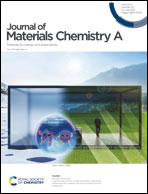Rapid and efficient removal of Cr(vi) by a core–shell magnetic mesoporous polydopamine nanocomposite: roles of the mesoporous structure and redox-active functional groups†
Abstract
Chromium is recognized as one of the most harmful heavy metal pollutants. Facile and efficient Cr(VI) removal technology is an urgent need, but still a challenge. Here, a novel core–shell magnetic mesoporous polydopamine nanocomposite adsorbent (Fe3O4@mesoPDA) was prepared by in situ polymerization of dopamine on the surface of Fe3O4 nanoparticles. The adsorption of Cr(VI) was highly pH-dependent, and optimal Cr(VI) adsorption occurred at pH = 1.5 with a maximum adsorption capacity of 574.71 mg g−1. The adsorption kinetics results showed that the large-sized mesoporous polydopamine shell layers of Fe3O4@mesoPDA significantly increased the adsorption sites and removal rate of Cr(VI), and its inner core Fe3O4 nanoparticles could also accelerate Cr(VI) removal. The adsorption mechanisms of Fe3O4@mesoPDA were primarily redox reactions and also involved electrostatic interactions and coordination. Cr(VI) was mainly reduced to Cr(III) by catechol and imino groups of PDA shell layers, but the pathway of the superoxide radical reduction of Cr(VI) mediated by iron ions on the surface of Fe3O4 nanoparticles could promote the electron transfer between PDA shell layers and Cr(VI) and greatly improve the adsorption performance of Fe3O4@mesoPDA, especially under weak acid conditions. Meanwhile, newly generated Cr(III) was further immobilized onto Fe3O4@mesoPDA through coordination with N and O functional groups and recovered by magnetic separation in favor of decreasing the environmental hazard of heavy metal Cr. Overall, this work can provide new insights into the interaction mechanisms between PDA-based adsorbents and Cr(VI), and also offers a significant reference for the subsequent preparation of Cr(VI) adsorbents.



 Please wait while we load your content...
Please wait while we load your content...